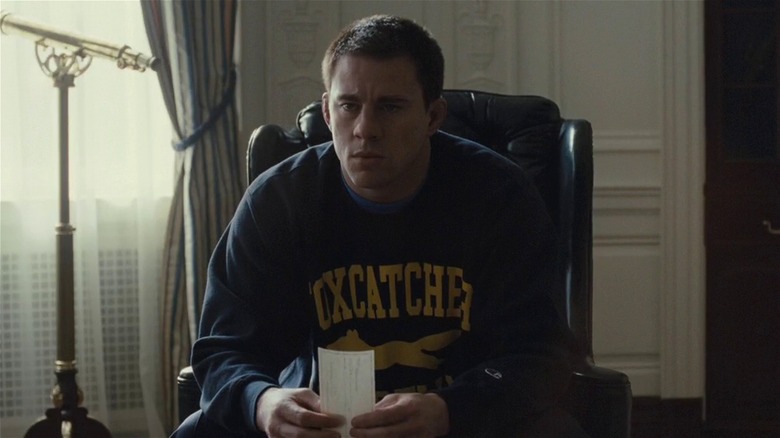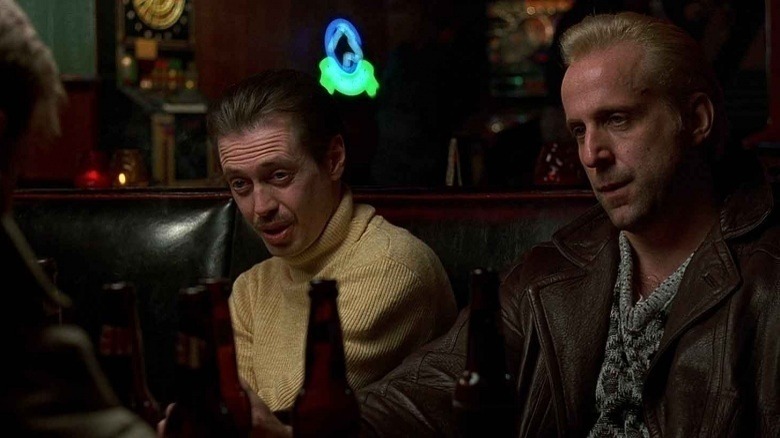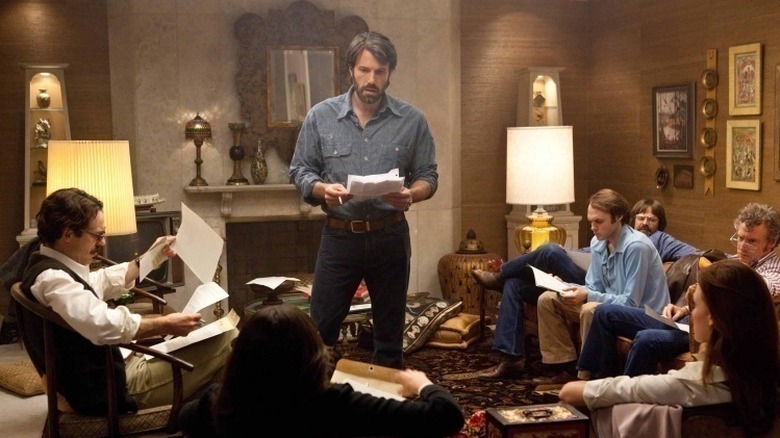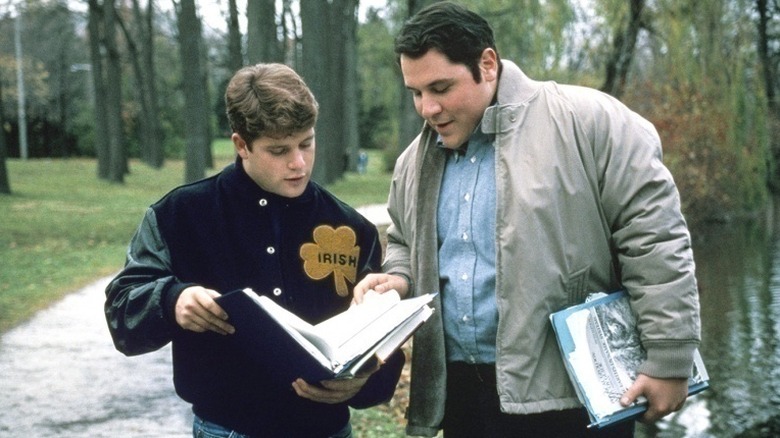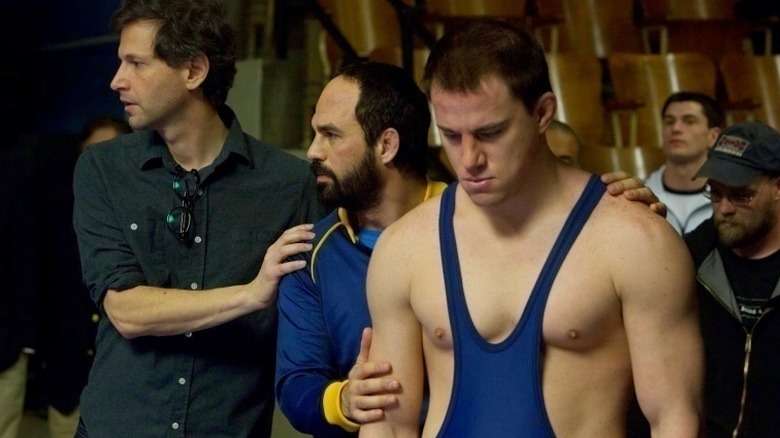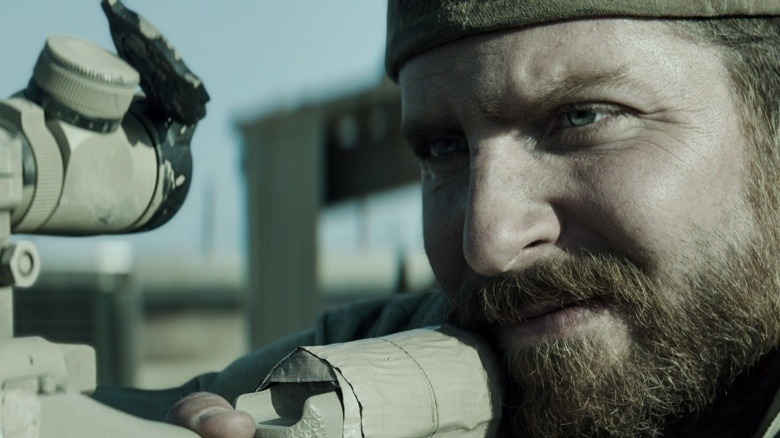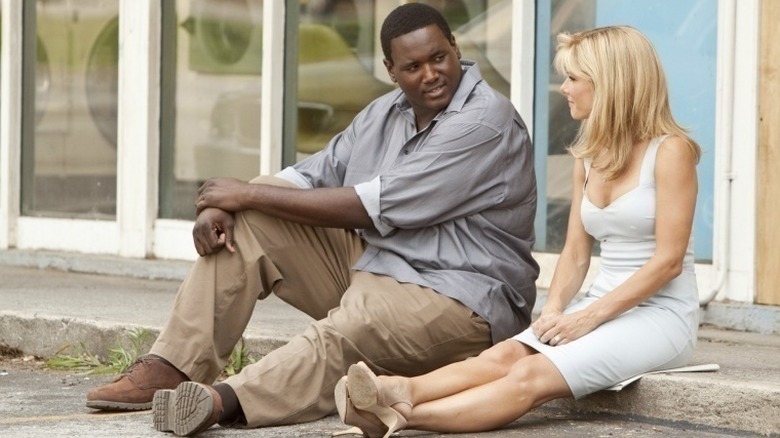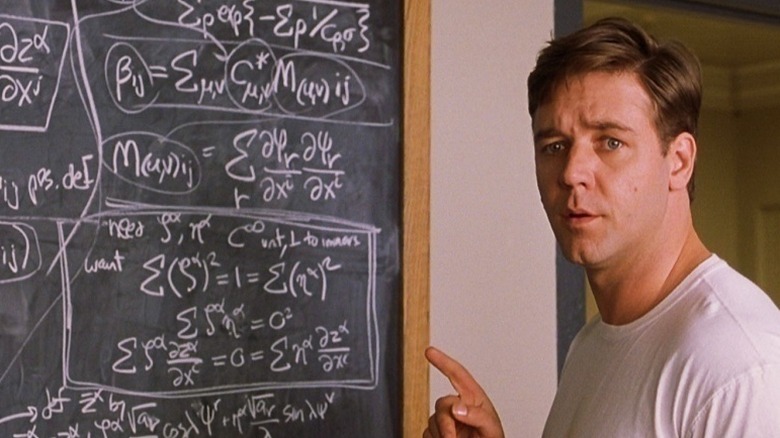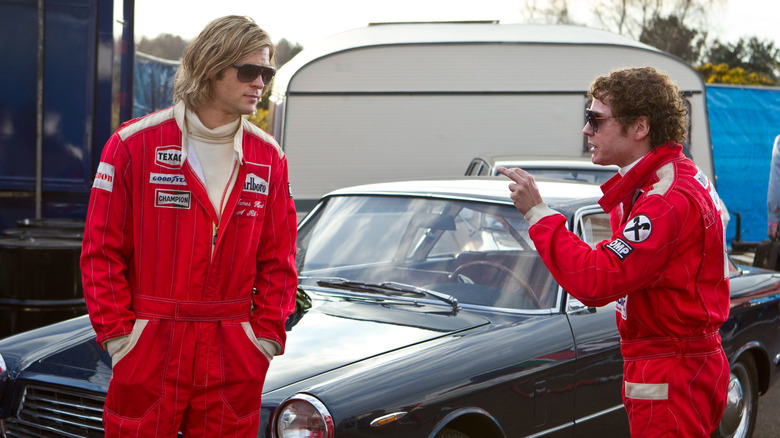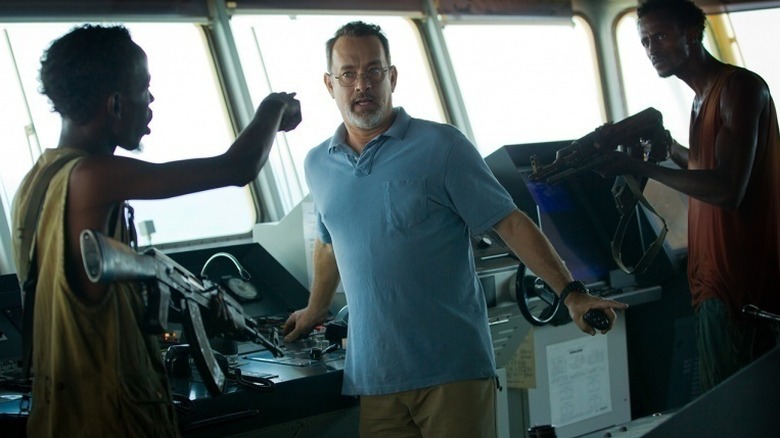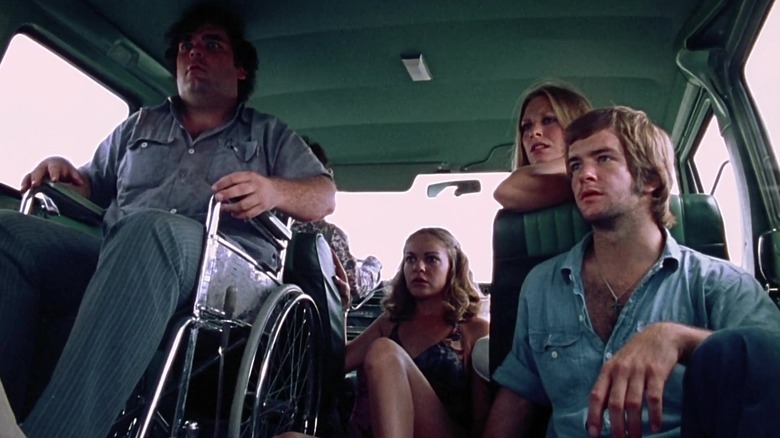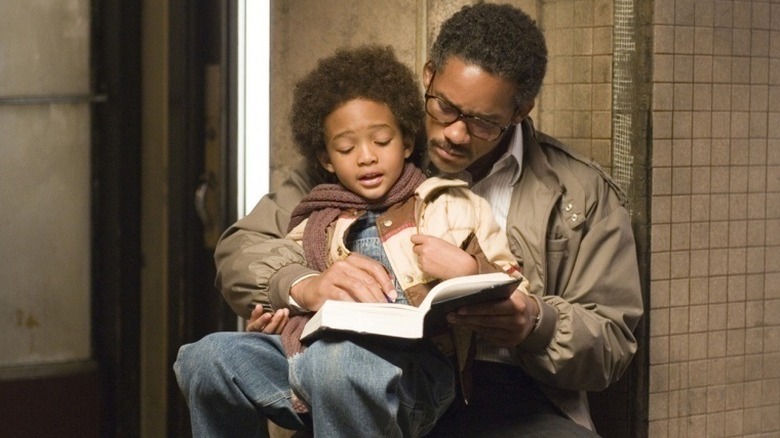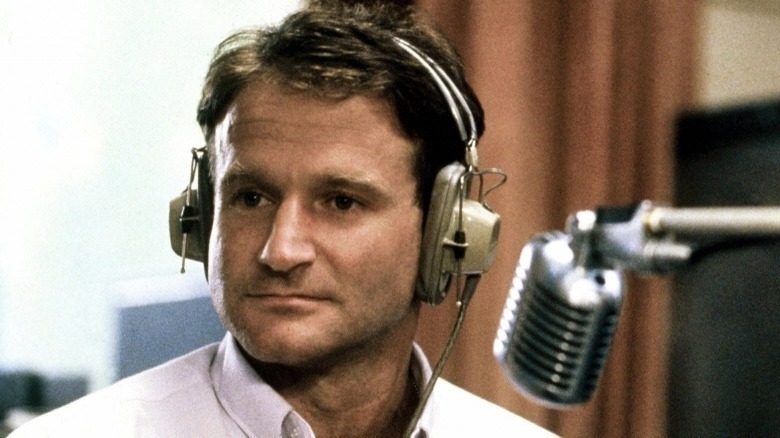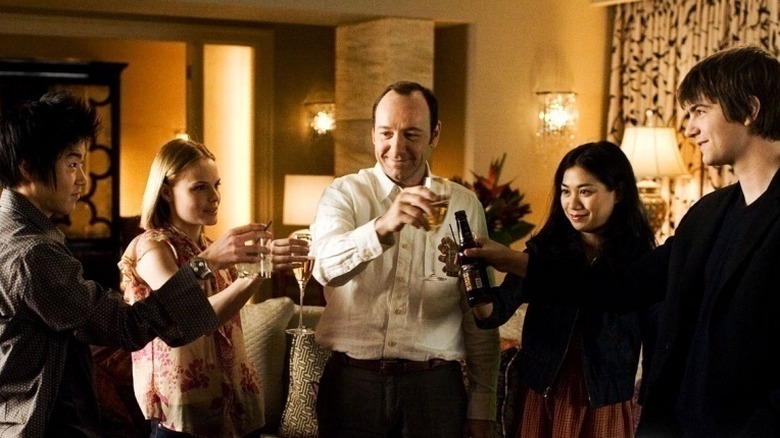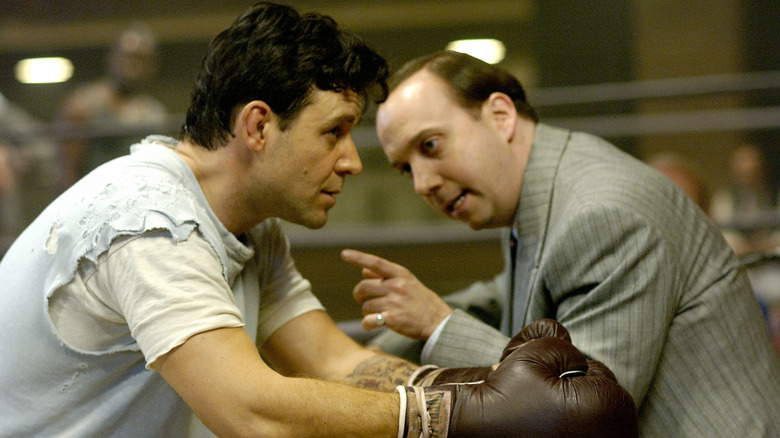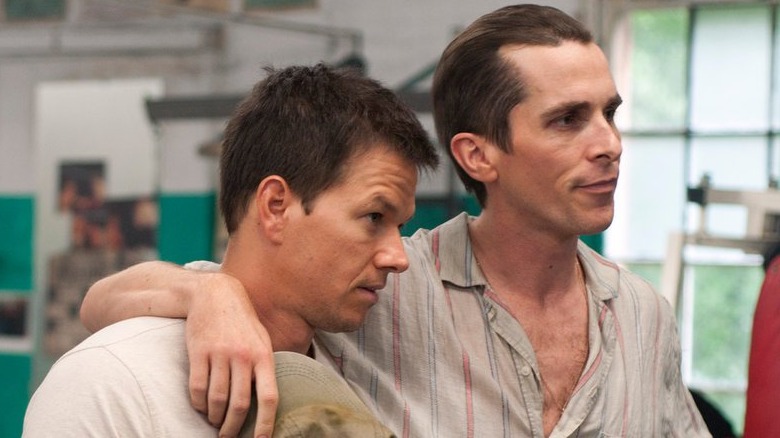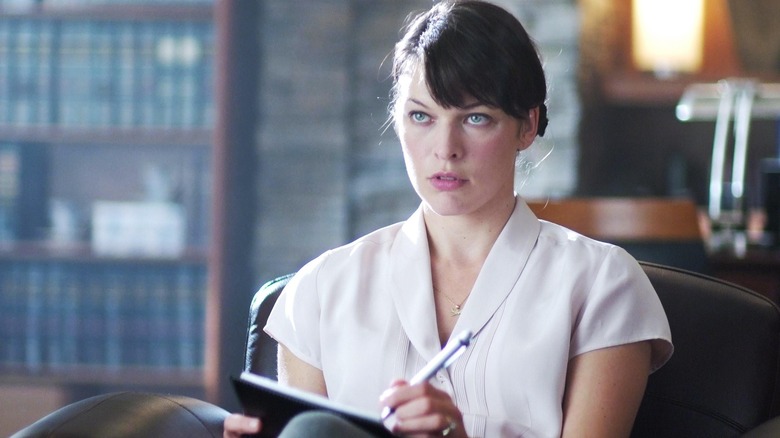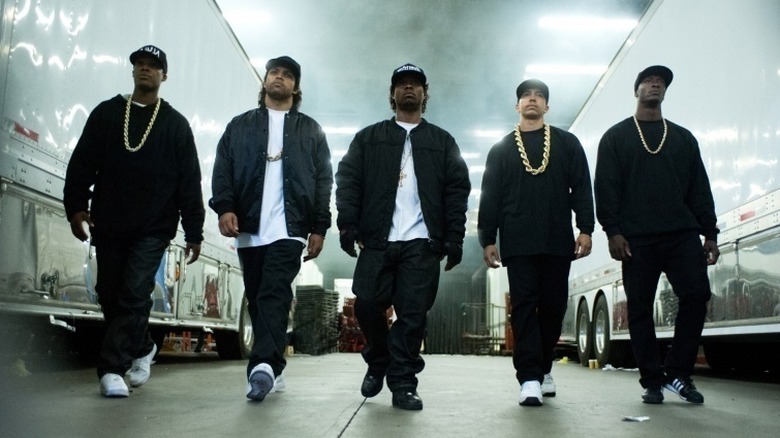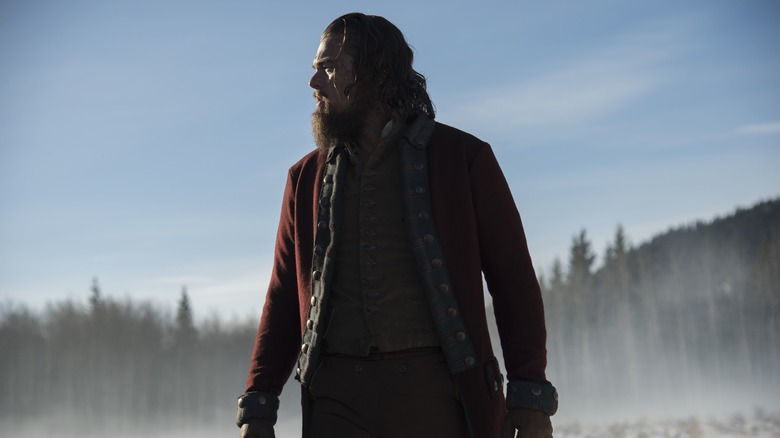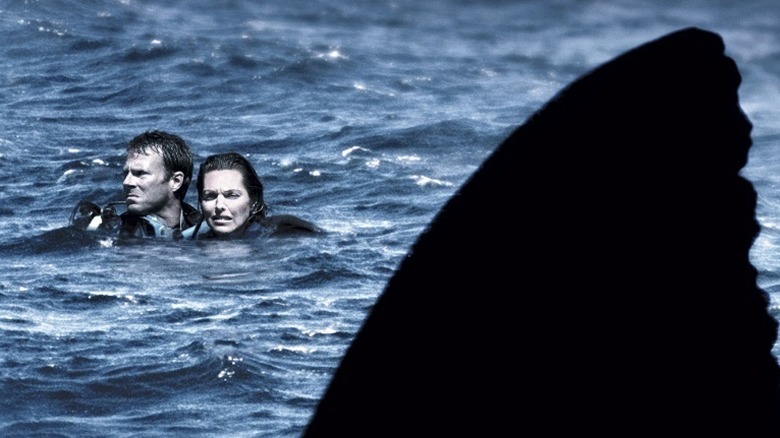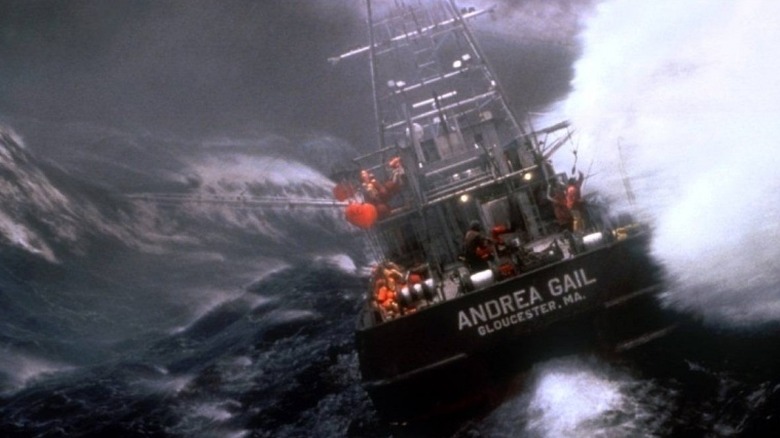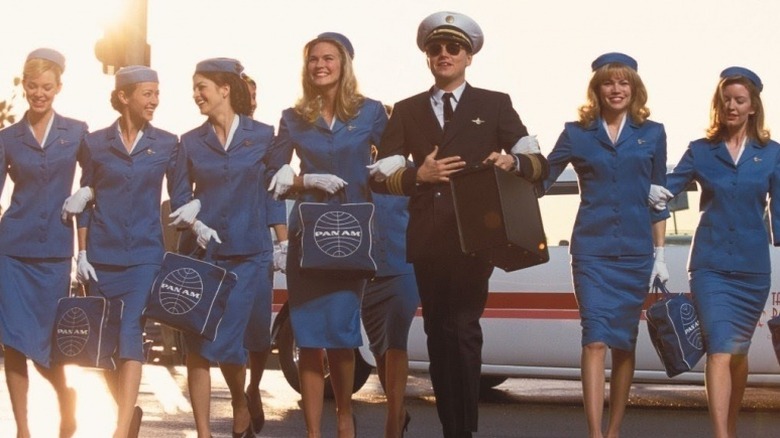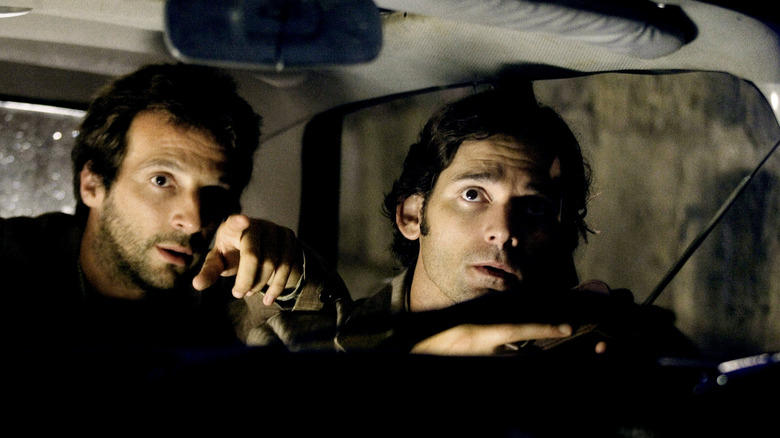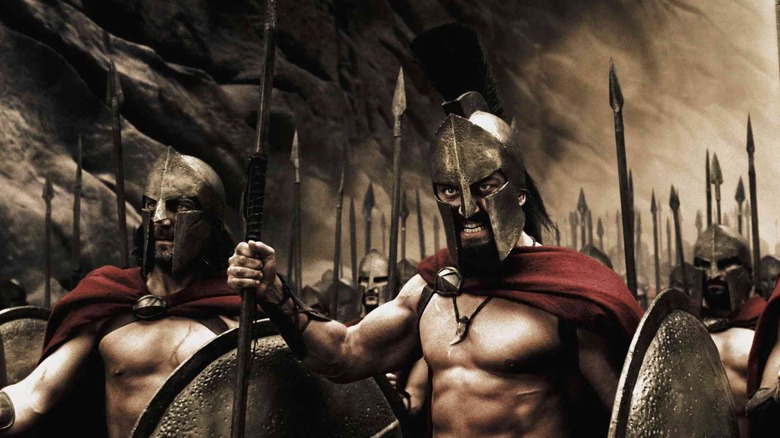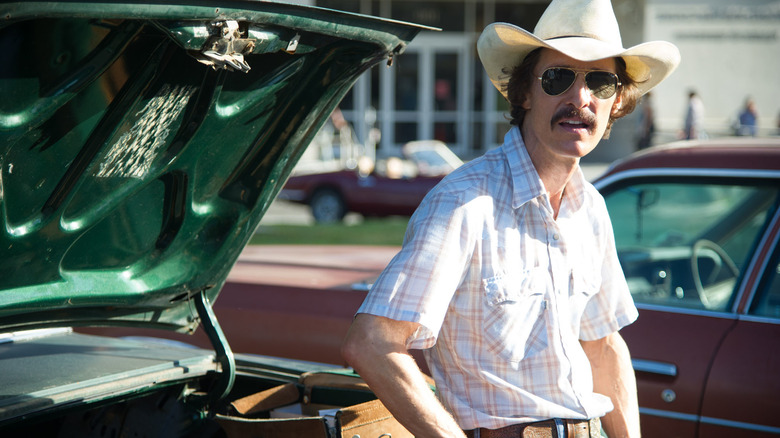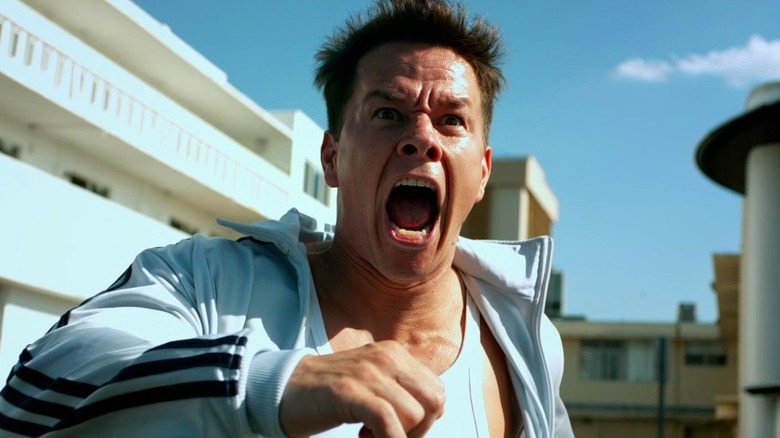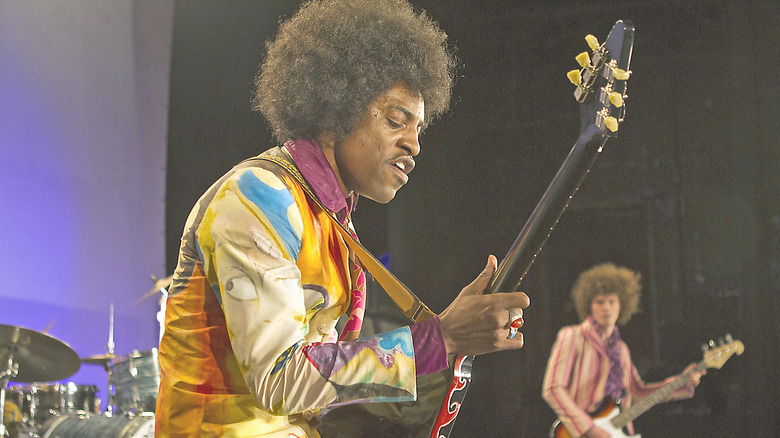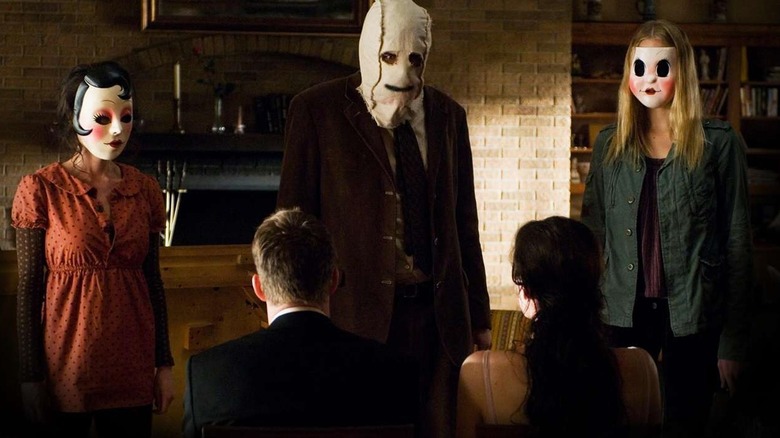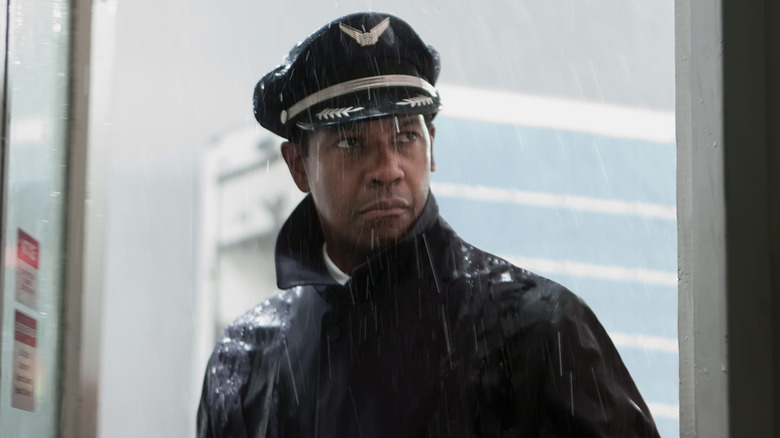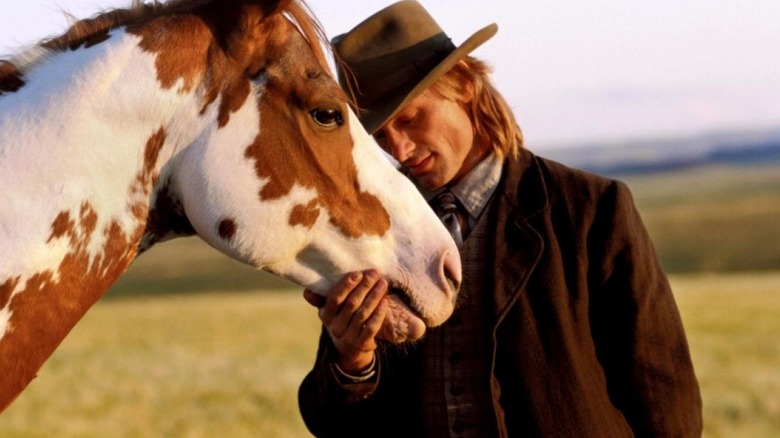True Story Movies That Lied To You
Adding the "true story" tagline is a common advertising tool for enticing unsuspecting moviegoers into buying box office tickets. As we all know, Hollywood has a habit of sensationalizing things and twisting the truth; sometimes, history can be a little too dull, and creative teams alter what really happened in order to keep audiences captivated. It's time to look past the silver screen and see why being "based on a true story" isn't always all it's cracked up to be.
Fargo (1996)
Fargo starts with text that says "THIS IS A TRUE STORY," adding that the events of the film happened in Minnesota in 1987. In reality, writer-director duo Joel and Ethan Coen loosely based the script on actual events and formulated the events before and after it. In 2016, 20 years after the movie's 1996 debut, they finally revealed their inspirations in an interview with The Huffington Post.
"There are actually two little elements in the story that were based on actual incidents," explained Joel. "One of them is the fact that there was a guy, I believe in the '60s or '70s, who was gumming up serial numbers for cars and defrauding the General Motors Finance Corporation. There was no kidnapping. There was no murder. It was a guy defrauding the GM Finance Corporation at some point. The other thing based on something real: there was a murder in Connecticut, where a man killed his wife and disposed of the body—put her into a wood chipper. But beyond that, the story is made up."
Argo (2012)
Ben Affleck's Argo was huge in 2012, winning three Academy Awards, including Best Picture. Alas, it's also fairly factually inaccurate, especially the way it minimizes Canada's role in the whole hostage-extraction plan that drives the story. None other than President Jimmy Carter himself called out Argo for making stuff up, saying "90 percent of the contributions to the ideas and consummation of the plan was Canadian. And the movie gives almost full credit to the American CIA." Carter specifically points out Ken Taylor (played by Victor Garber in the film) as the person he identifies as the main hero.
Rudy (1993)
Out of all the great football films we've seen over the years, Rudy is one of the most uplifting. It's also fast and loose with the truth. Remember that scene when the players place their jerseys on Coach Devine's desk to convince him to let Rudy play? And the crowd chanting his name? That never happened, and Joe Montana—who was on the team with Rudy—told sportscaster Dan Patrick that it didn't really go down that way. "It's a movie, remember," he cautioned. "Not all that's true. The crowd wasn't chanting, nobody threw in their jerseys. He did get in the game. He got carried off the game."
Foxcatcher (2014)
Foxcatcher depicts John du Pont's murder of Olympic wrestler Dave Schultz. Plenty of what appears on screen is accurate, but the filmmakers took lots of liberties with the timeline and characters' relationships, too.
For instance, the movie depicts du Pont's quick apprehension by the police after the murder, but in reality, the millionaire hid in his mansion's bomb shelter-like vault in a multi-day standoff. Viewers also don't really see how much time passes between Dave Schultz joining Team Foxcatcher (which happened in 1989) and his death. Around 1996, du Pont started losing interest in the sport as he announced he was ceasing his $400,000 annual contributions to the team—which wasn't featured in the film—months before he killed Dave. And while the movie makes it look like Dave's brother Mark quit wrestling completely after leaving the team, in real life he had actually been coaching the sport at Brigham Young University for years by the time his brother was killed.
American Sniper (2014)
Clint Eastwood's American Sniper has earned accolades, box office bank ... and controversy. Critics have pointed out differences between the life of Chris Kyle, the Navy Seal with the most confirmed kills in United States military history, and the way he's portrayed in the movie by Bradley Cooper. One of many distortions comes in the form of Mustafa, the enemy sniper Kyle battles: he only shows up in Kyle's memoir for one paragraph, whereas the movie portrays him as a longtime antagonist. In the book, Kyle's super-long-range shot of over 2,000 yards wasn't aimed at Mustafa, but someone carrying a rocket launcher. Likewise, Kyle's friend Ryan Job survives for years after being shot, as opposed to living for years in real life before dying of post-surgery complications.
The Blind Side (2009)
In 2009, The Blind Side showed how Michael Oher was adopted by a wealthy family and overcame the odds to become an NFL star. It earned Sandra Bullock an Academy Award—and it also inspired Oher to write a book setting the record straight. For starters, Oher said adopted mom Leigh Anne Tuhoy didn't actually have to teach him how to play football. "No, that's not me at all! I've been studying—really studying—the game since I was a kid!" he told NPR. "I felt like it portrayed me as dumb instead of as a kid who had never had consistent academic instruction and ended up thriving once he got it. Quinton Aaron did a great job acting the part, but I could not figure out why the director chose to show me as someone who had to be taught the game of football."
A Beautiful Mind (2001)
This Russell Crowe-led hit "A Beautiful Mind" took an uplifting look into the life story of economics Nobel Laureate John Nash—one that was unfortunately highly fictionalized. For starters, the real-life Nash never joined Wheeler Laboratory at MIT, because it doesn't exist. He did, however, become an instructor at MIT. Nash also never worked for the Department of Defense. The movie shows him as a dad, and he did become a father in real life...of a child out of wedlock, whose mother he abandoned. Nash also never actually gave an acceptance speech for his Nobel prize. Whoops?
Rush (2013)
The 2012 Formula One flick Rush generated some great reviews—but it's a racetrack full of historical exaggerations, one of the biggest of which is the way James Hunt and Niki Lauda are portrayed as bitter rivals. They were actually good friends, having once shared an apartment, and often went out for drinks. A few of the film's racing events unfolded differently in real life, and Hunt also never punched a journalist. But hey, journalist-punching sure does look cool in a movie.
Captain Phillips (2013)
Captain Phillips is based on the true story of the 2009 Maersk Alabama hijacking by Somali pirates, and the vessel's captain saving the lives of his team. But a crew member from the ship leveled accusations that the real Phillips isn't much of a hero at all, and that "no one wants to sail with him." According to his claims, Phillips practically invited the hijacking by ignoring safety protocols and sailing too close to the coast.
Phillips supposedly had multiple email warnings about increased piracy around Somalia. Those emails advised ships to stay at least 600 miles away from the coast, and Phillips' boat was more than half of that distance towards it. The crew also claims they endured two pirate attacks on that trip, and not just the one. Chief Engineer Mike Perry, who had a small role in the film, was apparently the most heroic, having brought the team downstairs and locked themselves in the ship's lower levels as the pirates raided the vessel.
The Walk (2015)
Let's just get this out of the way: yes, Philippe Petit's nail-biting tightrope walk between the two towers of the World Trade Center was real. He even walked back and forth a few times and did tricks, just as it occurs in Robert Zemeckis' The Walk from 2015. We're not trying to take anything away from what is probably the gutsiest stunt ever done. There was even a documentary done a few years about Petit's amazing journey. Unfortunately, the actual event was never filmed, so the documentary, Man on Wire, never featured any video footage of the stunt. As great as The Walk was and despite the intensity, this doesn't mean that the film didn't take any missteps in presenting the truth.
Director Robert Zemeckis and his team certainly did their homework, as most of the facts about the actual walk itself were true, including Petit's lack of harness/safety net, his previous walk between the towers of the Notre Dame in 1971, and the buildings' natural sway in the wind. As depicted in the film, he was arrested for the stunt, but the charges were dropped as long as he did a free performance at Central Park. Likewise, the buildings' owners forgave the guy and gave him a lifetime pass to the observation deck.
In Man on Wire, Petit claims he has never fallen during a stunt, which contradicts the movie's claim he once fell into a lake while walking. In real life, he did fall during a tightrope walk rehearsal at the circus and was seriously injured, but that doesn't count. Petit and his team actually had to do three trips to New York to prepare, instead of the one shown in the flick. According to The National Post (via Bustle), the movie didn't depict Petit hooking up with a groupie after being released by police, leading to his breakup with Annie Allix, which may have been why she flew back to France and he stayed in the States. Cheating on the lady who flew across the world to help you achieve your goal is a whole different kind of tightrope walk.
The Texas Chainsaw Massacre (1974)
Tobe Hooper's groundbreaking 1974 low-budget horror film The Texas Chainsaw Massacre may have been advertised as a true story, but it's far from it. While Leatherface is arguably on the Mount Rushmore of famous horror movie villains, he really didn't get his sadistic swag from a real-life chainsaw-wielding maniac. Like Psycho's Norman Bates and countless other macabre bad guys, Leatherface was loosely based on the real-life serial killer Ed Gein.
Gein, who confessed to killing two women, was known for exhuming corpses from graveyards and making keepsakes out of their remains. We're talking bowls made from skulls, skin-covered wastebaskets, and all kinds of morbid knickknacks at his home. While these actions heavily influenced the creation of Leatherface, his family, and the decor of the Sawyers' household, that's about it when it comes to The Texas Chainsaw Massacre being a true story.
The Pursuit of Happyness (2006)
Chris Gardner's rags-to-riches story is real, and certainly touts the rewards of perseverance and resilience, but its big-screen dramatization does exaggerate certain scenarios to increase its Hollywood appeal. Gabriele Muccino's 2006 movie The Pursuit of Happyness, adapted from Gardner's autobiography of the same name, stretched the truth on a few fronts.
For one thing, in the movie, Gardner's internship with Dean Witter, the stock brokerage company that gave him his start, was unpaid. In reality, though, Gardner received a $1,000 a month stipend during the 10 months (as opposed to the six seen onscreen) he worked with them. He also didn't go broke by selling defunct bone density scanners, although he did work as a salesman for medical supplies before making it big.
His arrest was also given the Tinseltown treatment, as he didn't come straight from jail to his job interview as the movie indicates. Most importantly, there was a stretch during his internship when his son (played in the movie by Smith's own son Jaden) did not live with him — in fact, for the first few months, he is said to have not even known the location of the boy, who was actually two instead of four as shown.
Good Morning Vietnam (1988)
The real-life account of Adrian Cronauer's time as a plucky disc jockey during the Vietnam War was intriguing enough, but when Robin Williams stepped in to portray Cronauer, things got a little carried away from the truth. Per Military Times, Cronauer admitted to the American Veterans Conference that he wasn't quite as kooky in reality as his onscreen persona, joking, "Those of you who have been in the military know that if I had done stuff that Robin Williams did in that movie, I'd still be in Leavenworth." He later added that the movie "was never intended to be a point-by-point accurate biography" but rather "a piece of entertainment."
Among the major changes in the jump from reality to fiction, Cronauer told The Chicago Tribune, was the fact that he wasn't actually kicked out of Vietnam as a result of his on-air antics—"I left when tour of duty was over," he explained—and he didn't have the same level of wit. "Williams is the disc jockey I would have liked to be," said Cronauer. "The movie is much more interesting than the experiences I had. The characters are composites, including me, of many real people ... Robin Williams is very funny. I'm not."
21 (2008)
The real blackjack team that used code phrases to bleed casinos dry and inspired the hit 2008 film 21 looked very different than it did onscreen. And while they did manage to make a ton of loot with their coded counting techniques, some of the scenes in the film (and the book upon which it was based, Ben Mezrich's 21: Bringing Down the House) just didn't happen.
For starters, the pic was yet another installment in Hollywood's whitewashing history, since most of the real people involved with the gambling team were Asian. One member, Jeff Ma, told Ain't It Cool News that he was fine with the decision to cast Jim Sturgess in "his" role, because of the thespian's talent and interest in getting the emotional truth of his story right. However, the differences were more than just skin deep. Ma also didn't get beaten up in the bathroom of a casino, as the film and book depicted, nor did he develop a romantic relationship with a female teammate, despite the dramatic window the scenes provided the movie.
Also, the basis for the central character Micky Rosa, played by Kevin Spacey in the movie, may not be much like the real-life trio of people behind the true story who claim to have inspired him. The founding threesome of MIT team leaders—John Chang, Bill Kaplan, and J.P. Masser—have each been given the shared honor of being the predominant inspiration for the character, but according to Kaplan, Rosa's not even a good composite of the trio. He said, "The fact is there is little, if anything, that resembles either of us except that he started and ran the team and was focused on running the team as a business."
Cinderella Man (2005)
Ron Howard's 2005 biopic Cinderella Man wasn't too off the mark when it came to the central story of pugilist James J. Braddock (Russell Crowe in the movie), a heavyweight champ who defeated Depression-era odds to come back from bitter defeat and financial distress and win the belt from Max Baer. However, the movie also turned his in-the-ring nemesis into a more cinematic villain than he was in real life.
While it's true that Baer did cause a gruesome death with his devastating fists, the way the film portrayed him as a miscreant who gloated about his coffin-ready conquest(s) wasn't accurate. His son, Max Baer, Jr., was reportedly enraged by the scoundrel his father was portrayed to be (by Craig Bierko) in the movie, saying, "The portrayal of my father in Cinderella Man couldn't have been more wrong and inaccurate. They turned a good-hearted, fun-loving, friendly, and warm human being who hated boxing into Mr. T from Rocky III with no redeeming characteristics."
Baer's own words about the incident indicate that the attitude he was portrayed to have—he was shown in the movie boasting about putting men in early graves—was exactly the opposite of how he reacted to the death of Frankie Campbell in real life. He once was quoted to state, "Nothing that ever happened to me—nothing that can happen to me—affected me like the death of Frankie Campbell." He actually ended up raising money for Campbell's widow and son after his death and is said to have had frequent nightmares about the loss.
Also, the idea that he would brashly take credit for the later death of Ernie Schaaf, who actually died months after his bout with Baer, seemed to be a sore spot for family members of the victim's side as well. Schaaf's sister-in-law was quoted as saying that the movie "even showed Ernie being dragged to the side and saying that was from the Max Baer fight. It isn't; it's from the [Primo] Carnera fight. That's when I really got upset." The film's most crushing blow, then, was to make Baer seem like a heartless foe when in reality, he was actually quite emotionally affected by what happened at his hand and certainly didn't lay claim to that which did not.
The Fighter (2010)
Another boxing movie that beat around the truth bush was David O. Russell's 2010 biopic of Micky Ward, The Fighter. In the movie, Ward is shown ascending to world champion status thanks to a successful bout with Shea Neary, while his fellow boxing brother Dickie Ward succumbed to addiction and engaged in a life of crime. But boxing aficionados note that the fight only won him the World Boxing Union junior welterweight title in 2000, and Micky Ward was never really recognized as a world champion, as the movie would have viewers believe.
The portrayal of the Ward sisters was also a point of controversy for their real-life counterparts. Alice Eklund, for example, told Men's Journal that she took umbrage to the film's portrayal of her family. "Those women were ugly. I never had hair like that. And Cathy—Cathy was a poster girl in the 1980s when she was waiting tables in Florida)." One of the sisters was reportedly so incensed by the portrayal that she left the screening of the film early. Even Dickie Ward, whose roller coaster of defeat marked Christian Bale's Oscar-winning portrayal, said "do you guys have to show my sisters and mother this way?"
The Fourth Kind (2009)
Olatunde Osunsanmi's 2009 sci-fi thriller The Fourth Kind was marketed as the true story of the mysterious disappearance of several people, possibly due to alien abductions, from Nome, Alaska in October 2000. The mayor of the town, Denise Michels, cautioned that the supposed true story that inspired the movie is quite different than what was shown, and this has caused her town's officials some immense headaches from truth-hunters who called in after the film's release. "People need to realize that this is a science fiction thriller," she told CNN. "Some of the calls I'm just ignoring because the issue we had to deal with in real life was very sensitive."
What really happened was a string of traveler disappearances in 2005, which the FBI investigated and determined was caused by a combination of alcohol consumption and freezing temperatures in the area. The fact that the movie poised itself as a combination of actual documentary footage, spliced together with mere dramatizations of the same, was a convincing seat-filler in the vein of the Blair Witch Project and Paranormal Activity, but the movie was ultimately labeled a hoax for its misrepresentations of the truth.
Straight Outta Compton (2015)
F. Gary Gray's 2015 hip-hop biopic Straight Outta Compton gave some critically acclaimed cinematic life to the rise and fall of '80s rap crew N.W.A., but left out a few key details about the group's members. Most egregiously, the film neglected to acknowledge the physical violence Dr. Dre is said to have inflicted on several women throughout his early career.
For starters, Dee Barnes, a television show host, was beaten by Dr. Dre in 1990 at a club after running a segment on the group that included the acrimonious departure of Ice Cube. In response to those allegations, Ren and Eazy-E simply suggested that Barnes "deserved" what happened to her and "had it coming." He was also said to be physically abusive with his former girlfriend Michel'le, with whom he has a son, and rapper Tairrie B. Murphy.
While the story of Dre's encounter with Barnes was included in the original script, it was ultimately cut from the film, and Gray dismissed the omission as being among the side stories that weren't "pertinent to [the] main characters." Dre did ultimately issue an unspecific apology in The New York Times, saying, "I apologize to the women I've hurt. I deeply regret what I did and know that it has forever impacted all of our lives."
The Revenant (2015)
Historical fact checkers had a field day when it came to parsing out the constructs of fiction in Alejandro G. Iñárritu's Oscar-winning 2015 film The Revenant. While Hugh Glass (played by Leonardo DiCaprio) was a real frontiersman who survived some perilous obstacles of nature—yes, even a bear fight—and the ills of mankind, there were still some made-up moments the movie added for dramatic flair.
Glass did not have a son in the historical record, so the movie's entire plot about him seeking vengeance against the men who killed his kid was twisted. And while he did go after John Fitzgerald (played by Tom Hardy) for leaving him to die in the woods, he never actually got the opportunity to have a face-to-face with him and show him mercy, as the movie showed. Instead, he gave up his search after finding out that Fitzgerald had become an Army member, and was thus protected by the federal government. He did, however, decide to give clemency to Bridger (Will Poulter), who was young and ashamed of his part in leaving Glass to die.
Open Water (2003)
It is true that American scuba divers Tom and Eileen Lonergan were inadvertently abandoned in the shark-infested ocean by the company that took them out to sea in Australia's Great Barrier Reef on January 25, 1998, but the rest of Chris Kentis' 2003 film Open Water is a product of pure imagination based on (and, in some instances, contrary to) the few clues that divers found about the couple's fate.
On the side of lending credibility to Kentis' take, an unrelated diving tour group did come across the pair's dive weights, which bolsters the movie's contention that the duo, named Susan and Daniel in the film version, dropped them in order to use their belts to fasten themselves together. A dive slate scrawled out by Tom was also later discovered by a fisherman, and the text of its plea for help indicated that they'd at least survived the night of their disappearance, as it was dated and timestamped from the next morning. On the other hand, certain parcels of their dive suits and gear were found and did not bear any indicators of struggles with sharks, as the movie imagined, so experts believe they merely ditched their scuba gear due to heat and delirium and probably died by drowning.
The Perfect Storm (2000)
In another instance of Hollywood running away with a fragment of the truth and making it into feature-length movie material, Wolfgang Petersen's 2000 blockbuster The Perfect Storm was a categorical cinematic stretch. Unlike some others of its ilk (like Open Water), The Perfect Storm opted to incorporate the real-life names of those whose narrative it exaggerated to elevate the believability of its events, but that didn't make the movie any more real.
Captain Billy Tyne (played by George Clooney in the film) really did decide to take out his fishing crew on his vessel Andrea Gail in October 1991, and the boat did sadly get swallowed by the sea during what was called a "perfect" storm collision of a hurricane and two other strong fronts. But the most dramatic moments of the crew's end were based on assumption and the wonders of CGI, and were based on very little actual knowledge of what happened. The movie was based on the 1997 Sebastian Junger book of the same name, in which the author pieced together accounts of other fishermen who'd been caught in the same squall that took the Andrea Gail, but his deductive estimations of what happened to Tyne & Co. were still just educated guesses.
Tyne's widow also took offense to Clooney's portrayal of her husband. "It was a bunch of lies," she told SeaCoast Online. "They make it look like he was greedy. He wasn't. He'd give you the shirt off his back." The flirtation Tyne engaged in with captain Linda Greenlaw was also said to be made up, as they reportedly hardly even knew each other, but the filmmakers may have drummed up the chemistry between the characters after finding out the call she received on her ship, Hannah Boden, transmitting his return coordinates did happen.
Catch Me If You Can (2002)
The international game of cat and mouse that ensued in Steven Spielberg's 2002 caper Catch Me If You Can wouldn't have been the same without Tom Hanks' FBI agent Carl Hanratty tirelessly pursuing Leonardo DiCaprio's version of the real-life Frank Abagnale, but if the movie had more thoroughly echoed reality, the former wouldn't have been a part of it at all. According to USA Today, Hanks' character was actually a combination of multiple agents who'd followed Abagnale through his many careers in con artistry.
One of the first scams he pulled off in the movie, too, was a concoction built for the big screen: namely when Abagnale, a high schooler himself, convinces a class that he's their substitute French teacher. Abagnale also pointed out the inaccuracy of the scene in which he's shown calling up Hanratty out of sheer desperation and loneliness on Christmas Eve, saying, "Why would I do that? I didn't want the FBI to know where I was."
Munich (2005)
Steven Spielberg's 2005 Olympic epic Munich was inspired by the true story of the 1972 Summer Olympics massacre of Israeli athletes (and the aftermath that ensued), but there were several departures from the truth and key omissions. As detailed by Slate, the so-called Black September targets who'd taken hostage and killed 11 Israeli Olympians were executed by various hit squads (instead of just one team), but the operation wasn't as clean as the moviemakers would have us believe. In fact, some civilians were believed to have been fatally caught in the fracas.
Some investigators even maintain that the very center of Spielberg's movie, a man named Yuval Aviv (nicknamed Avner, and portrayed by Eric Bana in the film) who claimed to have provided insider intel from the perspective of Mossad's assassination squad, may not have even served the Israeli forces during that time.
300 (2006)
Zack Snyder's 2006 fantasy epic 300 was a satisfying showcase of the might and will (and, let's face it, abs) of King Leonidas of Sparta and his fabled few men as they fought the legendary forces of Persia, but there were a lot of liberties taken by the filmmaker to formulate such a heart-pounding story onscreen. For one thing, there's reason to believe there were more than just Leonidas' bodyguards at the Battle at Thermopylae. He may have been joined on the battlefield by several thousand Peloponnesians, Boeotians, and Thespians.
Other details of the flick have been questioned as well, including the massive size (and intellect) of Xerxes, and the Spartans themselves could be rather mean. Snyder justified his changes in an Entertainment Weekly interview, admitting, "I didn't want to render Sparta in overly accurate terms, because ultimately I do want you to root for the Spartans. I couldn't show them being quite as cruel as they were. I made them as cruel as I thought a modern audience could stand." He added that the film's historical inaccuracies were "intentional" in hopes of inspiring his rapt audiences to check out the true stories.
Dallas Buyers' Club (2013)
Dallas Buyers Club is ostensibly the true story of Texan Ron Woodroof (Matthew McConaughey), who was diagnosed with AIDS in the early 1980's when such a diagnosis was almost certainly a death sentence. Woodroof took matters into his own hands, smuggling unapproved, experimental drugs into Texas in order to treat himself and others. While the film gets the broad strokes right, there's a great deal of characterization that it gets dreadfully wrong—including the fabrication of some characters who never existed in real life.
For starters, Woodroof himself is depicted as a competitive rider in rodeos, which he was not — screenwriter Craig Borten told Slate that this was a bit of poetic license he employed as a visual metaphor for the character's struggle. Other aspects of the character's personality were also embellished for dramatic purposes, such as his depiction as a bit of a homophobe and misogynist before his diagnosis (there's no evidence this was ever the case). However, the film's most egregious fudging of facts relates to the key characters of Eve Saks (a doctor sympathetic to Woodroof's cause and played by Jennifer Garner) and Woodroof's transgender business partner Rayon (Jared Leto, in a role for which he won an Academy Award). Neither of these characters has any real-life analog whatsoever — a fact made even stranger by the film's omission of some individuals who were important to the real Woodroof's life, such as his sister and daughter.
Pain & Gain (2013)
Michael Bay's Pain and Gain is a pitch-black comedy based on the real-life exploits of the Sun Gym gang, a group of bodybuilders who kidnapped a Miami businessman in an extortion plot in the 1990s. The film played fast and loose with the facts in countless ways both major and minor. While Daniel Lugo (Mark Wahlberg) and Adrian Doorbal (Anthony Mackie) are indeed based on real people, most of the film's other characters are either loosely based on real-life counterparts or are composite characters — and those involved in the real plot to kidnap Marc Schiller (called "Victor Kershaw" in the film) were nowhere near as bumbling as their film portrayals would lead one to believe.
The character of Paul Doyle (Dwayne Johnson), a born-again Christian who is also an addict, is a composite based on at least three different people, and the personalities of both the kidnappers and their victim were tweaked significantly to play up the film's comic elements. Schiller, in particular, has said that the film's Kershaw character (Tony Shaloub) bears "no resemblance" to him at all — and the kidnappers were, by all accounts, ruthless and violent people with nary an oafish, bumbling bone in their bodies. In addition, the film's third act, showing Doyle rob an armored truck, lose a toe in a shootout with police, and has Lugo fleeing by boat to the Bahamas before being chased down by pursuing cop, is almost entirely fictional. No such armored truck heist ever took place, and Lugo was arrested without incident in Miami.
Jimi: All Is By My Side (2014)
The Jimi Hendrix biopic Jimi: All Is By My Side — starring Outkast's Andre Benjamin as the mercurial guitarist — was a bigger hit with critics than it was with audiences, perhaps because those audiences were largely full of Hendrix fans who were annoyed by the film's inaccuracies. Jimi famously didn't feature any music that was actually written by Hendrix (his estate refused to license its use), which set its narrative on shaky ground to begin with, and the film didn't do itself any favors in the way it chose to manufacture drama by depicting Hendrix as an abusive, woman-beating lout.
Two scenes in the film involve physical altercations between Hendrix and girlfriend Kathy Etchingham (Hayley Atwell), the first depicting Hendrix beating Etchingham until she's on the ground crying and the second showing him smashing her over the head with a payphone. The scenes probably originated from an unauthorized Hendrix biography for which Etchingham was never interviewed, a trend which continued when the film's fact-checkers also failed to contact her. Etchingham has flatly denied that any such abuse ever took place, calling Hendrix "a gentle person" and slamming the scenes of abuse as "completely made up."
The Strangers (2008)
The poster for 2008's The Strangers insists that it is "Inspired by True Events," which led to rampant speculation among fans of the underrated slasher flick as to what those true events might be. Much of this attention has focused on the Keddie Cabin murders, a grisly quadruple homicide which took place at a remote cabin in the California woods in 1981. There is, however, zero evidence that this incident had any influence on writer/director Brian Bertino, and in fact the filmmaker has since gone on record that his story was actually inspired by "true events" that bear little resemblance to anything that happens in the film.
Bertino has said that one of his main inspirations for the story was Helter Skelter, the true-crime novel which chronicled the exploits of Charles Manson's murderous family, of which, none wore freaky masks or silently taunted their victims. The real seed for the story was planted when Bertino was a child: "As a kid, I lived in a house on a street in the middle of nowhere," the director said in an interview. "One night, while our parents were out, somebody knocked on the front door, and my little sister answered it. At the door were some people asking for somebody who didn't live there. We later found out that these people were knocking on doors on the area and, if no one was home, breaking into the houses." A far cry from the grisly events of his film, which is one story we should all be glad isn't exactly true.
Flight (2012)
The pivotal event in Flight is a harrowing plane crash, one which may or may not be related to drinking on the part of pilot Whip Whitaker (Denzel Washington). Whitaker is able to save nearly everyone on the plane by performing some insane aerial maneuvers, at one point even flying his jumbo jet upside down. The film won Washington an Academy Award for Best Actor, and its supposed basis in true events had audiences wondering if the fate that befell Whitaker — he was imprisoned after found to have been intoxicated on the day of the crash — actually happened. Only, Whip Whitaker never existed, and the events depicted in the film never took place.
The sole scene was based (very loosely) on an actual event was the crash, specifically of Alaska Airlines Flight 261, which happened in 2000. The plane's black box recording revealed that the pilots did indeed roll the plane upside down in order to try to pull it out of a nosedive — which is literally one of two things in the film with any basis in reality (the other being the cause of the crash, a faulty screw). There was never any suggestion that either of the Alaska Airlines pilots had been drinking, and, in stark contrast to the events of the film, their heroic efforts resulted in failure — Flight 261 crashed into the Pacific Ocean, killing everybody on board.
Hidalgo (2004)
Hidalgo is the inspiring story of Frank T. Hopkins (Viggo Mortensen), the first American to ever take part in the Ocean of Fire, a grueling endurance horse race across the Arabian Desert. The story was taken directly from the autobiography of the real Hopkins, whose account of his life was colorful, to say the least. In the book, he recounts his victories in dozens of endurance races across America as well as his friendships with historical figures like Black Elk and Buffalo Bill. His victory in the Ocean of Fire, with the help of his trusty steed Hidalgo, was a Hollywood-ready highlight in a bold and adventurous life. Only one problem: According to equestrian historians Basha and CuChullaine O'Reilly, it didn't happen. None of it did. Their research has proven pretty definitively that Hopkins was a complete fraud.
In their annotated version of Hopkins' book, the pair use historical records to methodically debunk each one of Hopkins' assertions, such as having been a rider for the U.S. Cavalry (they had no record of him), his friendship with Buffalo Bill (the curator of the Buffalo Bill Museum thinks not), and his victory in the Ocean of Fire, a race which probably didn't even exist. CuChullaine O'Reilly calls Hopkins' accounts "fantasies," and "the delusional ramblings of a very sick man" — which doesn't make for quite as solid a tagline as "Based on a true story."
